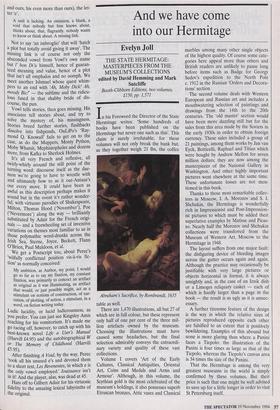And we have come into our Hermitage
Evelyn Jon THE STATE HERMITAGE: MASTERPIECES FROM THE MUSEUM'S COLLECTIONS edited by David Hemming and Mark Sutcliffe Booth-Clibbom Editions, two volumes, f150, pp. 1,571 In his Foreword the Director of the State Hermitage writes: `Some hundreds of books have been published on the Hermitage but never one such as this'. This claim is surely irrefutable, for these volumes will not only break the bank but, as they together weigh 21 Ibs, the coffee Abraham's Sacrifice, by Rembrandt, 1635 table as well.
There are 1,470 illustrations, all but 27 of which are in full colour, but these represent only half of one per cent of the three mil- lion artefacts owned by the museum. Choosing the illustrations must have caused some headaches, but the final selection admirably conveys the extraordi- nary variety and quality of these vast collections.
Volume I covers 'Art of the Early Cultures, Classical Antiquities, Oriental Art, Coins and Medals and Arms and Armour'. Although, in this volume, the Scythian gold is the most celebrated of the museum's holdings, it also possesses superb Etruscan bronzes, Attic vases and Classical marbles among many other single objects of the highest quality. Of course some cate- gories here appeal more than others and British readers are unlikely to pause long before items such as Badge for Georgy Sedov's expedition to the North Pole c. 1912 in the Russian 'Orders and Decora- tions' section.
The second volume deals with Western European and Russian art and includes a mouthwatering selection of paintings and drawings from the 14th to the 20th centuries. The 'old master' section would have been more dazzling still but for the sales from this area made by the Soviets in the early 1930s in order to obtain foreign currency. These sales included a group of 21 paintings, among them works by Jan van Eyck, Botticelli, Raphael and Titian which were bought by Andrew Mellon for seven million dollars; they are now among the masterpieces of the National Gallery in Washington. And other highly important pictures went elsewhere at the same time. These unfortunate losses are not men- tioned in this book.
Thanks to those most remarkable collec- tors in Moscow, I. A. Morozov and S. I. Shchukin, the Hermitage is wonderfully rich in Impressionist and Post-Impression- ist pictures to which must be added their superlative examples by Matisse and Picas- so. Nearly half the Morozov and Shchukin collections were transferred from the Museum of Western Art, Moscow to the Hermitage in 1948.
The layout suffers from one major fault: the disfiguring device of bleeding images across the gutter occurs again and again. Although the practice may occasionally be justifiable with very large pictures or objects horizontal in format, it is always unsightly and, in the case of an Iznik dish or a Limoges reliquary casket — each of which is hardly larger than a page in the book — the result is as ugly as it is unnec- essary.
A further tiresome feature of the design is the way in which the relative sizes of pictures reproduced opposite each other are falsified to an extent that is positively bewildering. Examples of this abound but none is more glaring than where a Panini faces a Tiepolo: the illustration of the Panini is four times as large as that of the Tiepolo, whereas the Tiepolo's canvas area is 34 times the size of the Panini.
That the Hermitage is among the very greatest museums in the world is simply confirmed by these volumes. But their price is such that one might be well advised to save up for a little longer in order to visit St Petersburg itself.


















































































 Previous page
Previous page